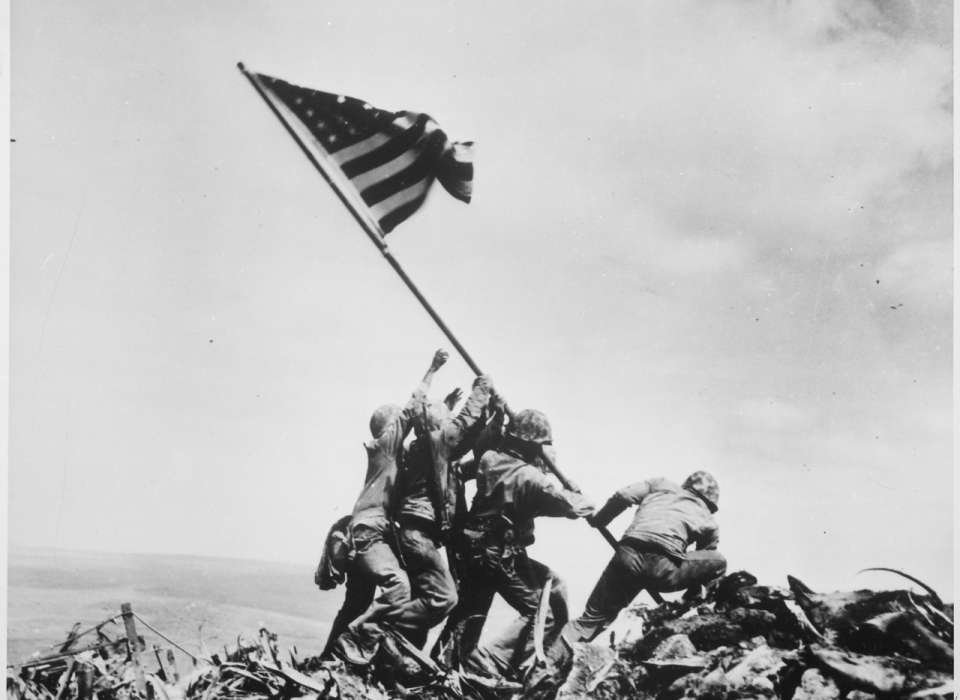RARE! Original 1945 TYPE ONE WWII Battle of Iwo Jima Holland M. Smith - Richard Kelly Turner Pre D-Day Briefing Press Photograph









RARE! Original 1945 TYPE ONE WWII Battle of Iwo Jima Holland M. Smith - Richard Kelly Turner Pre D-Day Briefing Press Photograph
Comes with a hand-signed C.O.A.
Size: 6 x 8 inches
This extremely rare and original TYPE ONE World War II press photograph of the Battle of Iwo Jima shows Lieutenant General Holland M. Smith Commander Expeditionary Troops for the assault of Iwo Jima, addressing a press conference aboard a transport at an advanced Pacific base before the assault on the Japanese island of Iwo Jima. At his right, seated is Secretary of the Navy James V. Forrestal and that his left Vice Admiral Richard Kelly Turner, Commander Amphibious Forces Pacific.
World War II stands as one of the most pivotal and devastating conflicts in human history, and within its vast tapestry of battles, the Battle of Iwo Jima holds a significant place. Lieutenant General Holland M. Smith emerged as a key figure in the planning and execution of this pivotal battle, showcasing his strategic acumen and leadership skills.
Lieutenant General Holland M. Smith, a distinguished Marine Corps officer, played a crucial role in the Pacific theater during World War II. As the Commanding General of the Fleet Marine Force Pacific, his responsibilities included planning and executing amphibious operations, making him a central figure in the Battle of Iwo Jima. Smith's military career was marked by a deep commitment to the Marine Corps and a reputation for meticulous planning and leadership.
The Battle of Iwo Jima, fought from February 19 to March 26, 1945, was a pivotal engagement in the Pacific campaign. The small volcanic island of Iwo Jima, located halfway between the Mariana Islands and Japan, held immense strategic importance for the Allied forces. It served as an ideal location for Japanese airfields, providing a critical base for intercepting U.S. bombers on their way to Japan. Recognizing the significance of capturing Iwo Jima, Allied planners, including Lieutenant General Smith, devised a meticulous strategy for the assault.
Lieutenant General Smith's role in the Battle of Iwo Jima was multifaceted. He was responsible for coordinating the various elements of the Marine Corps, Navy, and Army involved in the amphibious assault. Smith worked closely with Vice Admiral Turner, Commander Amphibious Forces Pacific, to ensure a well-coordinated landing and subsequent operations. His strategic vision emphasized the need for thorough intelligence, effective naval and aerial bombardment, and careful coordination of ground forces.
Secretary of the Navy James V. Forrestal also played a vital role in the preparation for the Battle of Iwo Jima. As the civilian head of the Navy, Forrestal worked to ensure that the necessary resources, including ships, aircraft, and manpower, were allocated to support the operation. His collaboration with military leaders like Lieutenant General Smith demonstrated the seamless coordination between civilian and military authorities during this critical phase of the war.
Vice Admiral Richard Kelly Turner, as Commander Amphibious Forces Pacific, was responsible for the naval elements of the Iwo Jima assault. His task included transporting and landing the Marines on the beaches while providing naval gunfire support and protection against Japanese naval and air counterattacks. The success of the amphibious assault hinged on the coordination between Turner's naval forces and Smith's ground forces, emphasizing the importance of joint operations.
The Battle of Iwo Jima was characterized by intense fighting, as U.S. Marines faced formidable Japanese defenses, including an intricate network of tunnels and bunkers. Lieutenant General Smith's leadership was put to the test as the Marines fought doggedly to secure the island. Despite the challenges, the Marines, with support from naval and air forces, managed to capture Iwo Jima. The battle was a costly victory, with both sides suffering heavy casualties, but it marked a crucial step toward the eventual Allied victory in the Pacific.
In conclusion, Lieutenant General Holland M. Smith's role in the Battle of Iwo Jima was instrumental in shaping the outcome of this critical engagement. His strategic planning, coordination with naval forces led by Vice Admiral Turner, and collaboration with Secretary of the Navy Forrestal exemplified the synergy required for successful joint operations. The Battle of Iwo Jima, with its high human cost, highlighted the determination and sacrifice of the U.S. Marines and showcased the effectiveness of Allied planning and execution in the Pacific theater during World War II.